|
|
|
| Published
on 4
Mar
2010 |
All rights reserved.
|
|
|
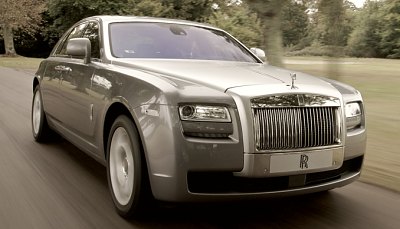
|
Baby Roller targets at Bentley
Mulsanne rather than Continental...
|
A
couple of years ago, we
were told that BMW was developing a "baby Roller" to rival Bentley
Continental Flying Spur. It shall sit below the £280,000 Phantom,
but above the £100,000 mainstream luxury cars like Mercedes S600.
Considering Bentley's best selling saloon is priced at £120,000
to £140,000, it was easy to assume the baby Roller occupy the
same territory. Market analysts described this territory as a sweet
spot – on the one hand it may attract up to ten thousands customers a
year, on the other hand it is still totally free from the competition
of mainstream luxury car manufacturers like Mercedes, BMW, Audi, Jaguar
and Lexus. In fact, in the past few years Bentley found big success
with its Continental line and turned around its fortune.
So the £200,000 Rolls-Royce Ghost struck us to the concrete
ground. It is only £80,000 cheaper than the flagship RR, and way
more expensive than Bentley Continental Flying Spur. Its target rival
seems more like Bentley Mulsanne, which will go on sale at
£220,000 this summer. Rolls-Royce' salespersons will find a hard
time to meet their sales target. To most of us, however, this is not a
bad thing. Basically, £200,000 or £130,000 make no
difference to us. Both are unimaginable figures and both are out of our
reach. What matter to us is how the £70K difference reflect in
the car's looks, build quality and ingredients.
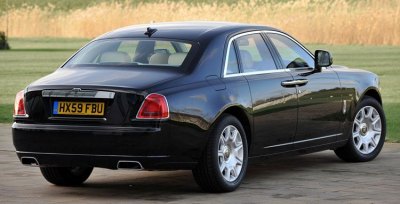
|
Like a 90-percent scale Phantom...
|
From this point of view, I would say
the baby Roller (well,
maybe not so baby now) is definitely worth the extra money over Bentley
Continental. While the Continental is fine, it doesn't feel too
different from Mercedes S600. Style aside, it may just happen to be a
Volkswagen or Audi flagship. In fact, some Continental Flying Spurs
were once assembled by the Dresden plant in Germany when Crewe ran out
of capacity. These cars looked and felt exactly the same as those built
in England. Rolls-Royce Ghost is very different. It looks and feels
nothing like a mainstream luxury car, but rather like a 90-percent
scale Phantom. For sure, there is a little deviation in its character -
it looks slightly rounder, lighter and more performance-minded,
probably more suitable to customers who would occasionally drive their
cars - in this way very much like Bentley. However, its bloodline is so
obvious to be an extension of the flagship Phantom. It preserves the
prestige and dignity as the best-built car in the world. Subjectively,
its superiority over Continental is more than £70,000 can
explain. From this perspective, we can even describe it as a bargain.
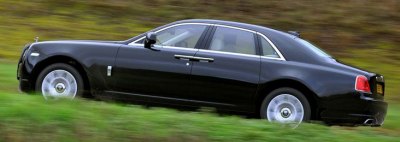
|
"Small" is probably the last word you
would use to describe this car...
|
The
Ghost started life in BMW's Dingolfing plant, where its steel monocoque
chassis is built and painted. However, its final assembly and interior
trimming are performed at Goodwood by British craftsmen in good old
tradition. Unlike the aluminum spaceframe Phantom, Ghost employs
conventional steel monocoque to cut cost. This hasn't reflected on
scale though - the Ghost weighs 2360 kilograms, some 125 kg lighter
than the standard-wheelbase Phantom, primarily because it is 430 mm
shorter, 40 mm narrower and 80 mm lower. Nevertheless, "small" is
probably the last word you would use to describe this car. Despite of
the downsizing, it still measures some 5.4 meters in length, 1.95
meters in width and 1.55 meters in height. Even in short-wheelbase
form, its wheelbase easily eclipses the long-wheelbase Mercedes S-class
by 130 mm !
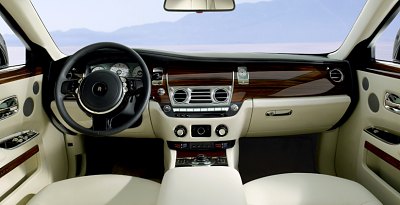
|
The driver sits much lower than
Phantom, although view over the road is still way more "commanding"
than others...
|
Rolls-Royce keeps the most prestigious features of Phantom
intact in the smaller car, i.e. the rear-hinged "suicide" passenger
doors and the nice umbrellas stored inside which. So you enter the rear
cabin with unrivaled grace, sit "on" the high-mounted sofa and discover
the cabin isn't much smaller than the concert hall of Phantom, thanks
to the superior space efficiency of steel chassis. More differences lie
on the front though. The driver sits much lower than that of the large
RR, although the view over the road is still way more "commanding" than
other luxury limousines. The environment up front is snugger than
Phantom's, although that is relative again. The dashboard looks more
modern and conventional, with large pieces of wood flowing smoothly
from one side to another. The cabin design is simple and elegant.
Needless to say, woods and leather are top notch items, with good
craftsmanship to match. Nevertheless, a few glitches show signs of cost
saving, such as the chromed switches (which are actually plastics) and
the plastic door pulls. Besides, the Phantom's wooden dashboard looks
more like a hand-built furniture. These areas still put the Phantom in
superior position.
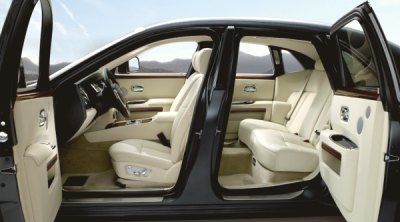
|
Best features of Phantom are kept:
suicide doors and nice umbrellas
|
The Ghost has 20 percent components sourced from BMW 760Li.
One of which is the direct-injection twin-turbo V12. However, to show
the superiority of Rolls-Royce, BMW enlarged its displacement by 10
percent to 6592 cc - what a pity they couldn't quite achieve 6750 cc -
hence boosting its output by 26 hp to 570 hp and its maximum torque by
22 lb-ft to 575 lb-ft, and the latter is available from as little as
1500 rpm ! Moreover, coming together with the twin-turbo V12 is the
latest ZF 8-speed automatic transmission. Now you can see what the
Ghost excels over Phantom... 24 percent more power, 5 percent less
weight, smaller frontal area and a couple of extra gears to use
translate to 0-60 mph acceleration in 4.7 seconds, more than one second
ahead of its supposedly superior sister, and most likely faster than
Bentley Mulsanne as well. Smaller and cheaper does not equal to slower.
On the contrary, these qualities give the baby Roller a more suitable
basis to pursue a performance character never attempted by Rolls-Royce.
Apart from powertrain, the Rolls-Royce also shares the 7-series'
electronic systems, climate control and suspension parts - the
things
you cannot see. However, it is not to say it rode on the 7-series
platform. Far from it actually. Its very different proportion, weight
and ride characteristic require a unique platform to realize. Even the
shared parts are altered to work better on the Roller. For example,
while the 7-series has adaptive air springs at its rear axle only, the
Roller has them on both axles, and they are tuned to deliver roughly
the same frequency response as that of Phantom.
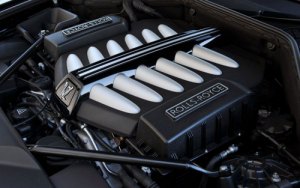
|
The Ghost has 20 percent components
sourced from BMW 760Li. Twin-turbo V12 is one of them.
|
On the road, the Rolls-Royce feels so different from a 760Li. Its ride
is truly cosseting, gliding over the poorest surfaces with little drama
and noise. The cabin is so well insulated from the world outside. The
V12 is incredibly smooth and quiet. The superb level of refinement
reminds us what made Rolls-Royce so famous in the early years. Now we
know why it reuses the name "Ghost".
Ultimately, Phantom can still teach its little sister a thing or two in
ride quality, especially over big potholes, but Ghost is about the only
car that comes close to it.
However, what surprises us is the sporting flavor found on the new
Rolls-Royce. Once you prod the gas pedal, you will be amazed by the
strong stream of g-force and the uncorrupted acceleration achieved by
its V12 and eight-speed automatic. From the magnitude of g-force, we
can say the 0-60 mph claims of 4.7 seconds is every bit believable. If
not the lack of noise, you might even confuse the car with a sports
saloon.
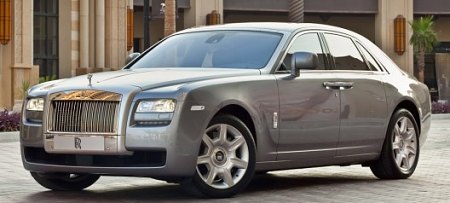 |
If not the lack of noise, you might
confuse it with a sports saloon...
|
In corners, the Roller is not as agile
or as flat as a
7-series, of course. But it still amazes us with new found level of
body control, thanks to the adoption of BMW's active anti-roll bars. As
pitch and roll is greatly reduced, it feels much much smaller than
Phantom. Some American motoring journalists even described it as
"sporty", which is probably exaggerated. The Ghost does provide a good
steering though – surprisingly accurate and feelsome. Its huge brakes
also provide exceptional stopping power and good pedal feel. As a
result, it will give the forthcoming Bentley Mulsanne a hard life.
However, to ask it to handle like the smaller 7-series, S-class, A8 or
XJ is unreasonable. No cars at this weight and with so high center of
gravity can do that. I guess Rolls-Royce does not bother about that at
all. If not, it should have already provided a "Sport" button for
sharpening its suspensions, steering, gearshift or throttle. In fact,
"comfort" is the only mode on offer. It is the basis of all
Rolls-Royces in the past 100 years, and has no reason to take second
priority this time around. We are glad that RR has not forgotten about
its core values while pursuing to steal sales from Bentley.
|
Verdict:     |
Published
on 11
Sep 2013
|
All rights reserved.
|
|
Rolls-Royce Wraith
|
|
There are two kinds
of people who would buy a Rolls-Royce Wraith. One is those wanting to
show off their enormous wealth. In this case, a Rolls-Royce Ghost or
Phantom is usually considered not enough because they are simply too
functional. The Wraith is neither a limousine nor a proper performance
car. It implies the driver already owns a big Roller or Bentley 4-door
for everyday use and simultaneously a Ferrari, Aston or Lamborghini for
weekend fun,
but still have the money and desire for something different. Another
kind of buyers is those appreciating the finest build quality and
craftsmanship but unhappy with the conservative styling of Ghost,
Phantom or Mulsanne. The Wraith is by no means a beautiful car, but its
strange front and back ends might appeal to some with acquired taste.
Built on a shortened Ghost platform, the Wraith is best to be seen as
the Ghost Coupe. Its wheelbase is 183 mm shorter, but still measures a
massive 3112 mm, which is longer than a Mercedes S-class! Needless to
say, its rear seats are full-size, offering head and legroom matching
many full-size saloons. Entry to the cabin is made graceful by the
unusual rear-hinged doors. Note that those doors are mounted at the
body sides which have no B-pillars to support. The steel monocoque
structure must be very stiff, otherwise any tiny deflection would cause
the doors to damage the body shell or glass. The narrow gaps between
the doors and the surrounding body also show how Rolls-Royce is
confident about its immense rigidity.
The lavish interior is purely Ghost. The same dashboard is made of the
same quality wood, leather and aluminum (although some minor BMW
switchgears are still eyesores to buyers at this level). Big comfy
chairs and thick
wool carpets provide a similar seating experience. Ditto the big
steering wheel and the commanding driving position. It feel every bit a
proper Rolls-Royce.
Rolls-Royce said this is its most powerful model, as its 6.6-liter
twin-turbo direct-injected V12 is tuned to deliver another 62
horsepower and 15 pound-foot of torque, pushing the total to 632 hp and
590 lbft. This is also the most powerful engine BMW has ever built,
eclipsing the mighty McLaren F1 engine by 5 horses. However, it has to
haul some 2360 kg of mass, which is actually no lighter than the Ghost
(why?), thus performance is brisk rather than lightning. 0-60 mph can
be done in 4.4 seconds, but in the well-insulated cabin the sensation
of speed is more modest. You can easily travel at double the speed you
thought. The V12 has no discernible turbo lag, and its
power is delivered smoothly and quietly through the ZF 8-speed auto.
Rolls-Royce said the gearbox is linked to the satellite navigation
system to predict the road ahead and offer quicker/smoother shifts, but
in reality it is hard to tell.
As said, the Wraith is not a true performance car – in fact, no cars
weighing so much and standing so tall from the ground can be. Its
adaptive air suspension is set stiffer than that of the Ghost, but not
enough to damage the comfortable ride. Overall, this is still a
comfort-biased setting. Up the pace in corners and you will find plenty
of pitch and roll and understeer. The steering is too light and slow to
inspire
confidence. The same goes for the sheer size of the car and the fact
that you cannot see exactly where its corners locate, which hurts
confidence when driving on narrow roads. Like the Ghost, you can't dial
up the suspension and steering setting, because "Sport mode" is never
in the dictionary of Rolls-Royce.
Make no mistake, the Rolls-Royce Wraith is not a GT, despite of its
enhanced performance. It is actually a
2-door luxury car, just like the even more expensive Phantom Coupe.
Apart from the latter, it doesn't have any real rivals. In a segment so
niche, it is meaningless to say which one is better. It all depends on
the taste and preference of buyers.
|
Verdict:     |
Published
on 17
Mar 2016
|
All rights reserved.
|
|
Rolls-Royce Dawn
|
|
Rolls-Royce already
has a convertible in its line-up, i.e. Phantom
Drophead Coupe. However, that car is simply too pricey and
exclusive to fill the shoes of Corniche,
the iconic Roll-Royce convertible everybody still remember. Throughout
its long life of 25 years, Corniche was popular and hugely profitable
to Rolls-Royce. It had virtually no competitors in the market place,
yet the car was not too costly to build as it was derived from the
relatively “mass production” Silver Shadow. To repeat the success of
Corniche, obviously, Rolls-Royce needs a more accessible convertible
based on its mainstream saloon, Ghost. And this resulted in Dawn.
The development of Dawn is made easy by the fact that the Ghost was
already derived into a 2-door coupe, Wraith, a
couple of years ago. Most of the chassis structure of the new
convertible is shared with the coupe, including its shorter wheelbase
and the unique rear-hinged doors. You might remember that the Wraith
had no B-pillars, so its body sides and underfloor structure was
already strengthened to provide solid mounting for the doors. This
undoubtedly benefits the open-top version as well, thus it requires few
additional reinforcement. This means, even though the power soft top is
massive, thick and completed with glass window, the Dawn weighs only
200 kg more than Wraith. At 2560 kg, it is not overweight by the
standards of Rolls-Royce.
In many ways the Dawn is more likable than Wraith. First of all, it
looks far more graceful, especially with the roof down, than the Wraith
with its odd fastback design. Then it enables the romance of open-air
motoring without much sacrifice. In fact, it is even more refined than
the coupe. Once its 6-layer fabric roof is closed and double-glazing
windows are up, its cabin is actually quieter. There is precious little
wind and road noise could penetrate into the cabin, making it the
quietest convertible we have ever seen. The body structure feels just
as solid as the coupe’s, with no scuttle shakes even on broken
surfaces. Surprisingly, the 4-seat cabin loses no space, offering the
same amount of legroom and even a bit more headroom to the two sitting
at the back. This is the only convertible capable of sitting 4 large
adults without compromises. Not even Phantom Drophead Coupe could claim
the same achievement.
The rest of the car is very similar to Ghost and Wraith. It has the
same dashboard and interior trimming, which is warm, lavish and mostly
bespoke (except those BMW switches, again). The 6.6-liter turbocharged
V12 has the same tune as the Ghost. Although not quite as powerful as
Wraith, it still offers as many as 570 horsepower and 575 pound-foot of
torque from very low revs for your disposal. No one would drive it as
in a sports car, but it won’t disappoint those in a hurry with the
capability to do 0-60 mph in 4.7 seconds or topping 155 mph before
electronic limiter kicks in. I doubt if anyone needs an open-top car to
go faster. If there are really someone, they must be already owning a
Ferrari 488 Spider.
The Dawn is a completely different experience from Ferrari, of course.
All controls are light and easy. The steering offers little to no feel
but it guides the car accurately. The air suspension is soft and
pillowy (though the setting is unchanged from Wraith), but for a car so
huge its body control is admirable. The V12 is creamy smooth and
whispering quiet, noticeable only for its absence. Ditto the
satellite-linked 8-speed automatic transmission. This is not a car to
go fast or to thrill. On the contrary, it is for you to drive slowly
with a peace of mind, enjoying a relaxing holiday through beautiful
scenery, all the while showing off your enormous wealth. Nothing else
serves this purpose better than a Rolls-Royce.
|
Verdict:     |
|
|
|
|
|
|
|
|
|
|
Ghost
|
2009
|
| Front-engined,
RWD |
| Steel monocoque |
| Mainly steel |
| 5399 / 1948 / 1550 mm |
| 3295 mm |
V12, 60-degree
|
| 6592 cc |
DOHC 48 valves, DVVT
|
| Twin-turbo |
| DI |
570 hp / 5250 rpm
|
575 lbft / 1500 rpm
|
| 8-speed automatic |
F: double-wishbone
R: multi-link
|
Adaptive air spring + damping, active
anti-roll bar
|
F: 255/40YR20
R: 285/40YR20
|
2360 kg
|
155 mph (limited)
|
4.7 (c) / 4.9* / 4.3**
|
10.6* / 10.1**
|
|
Wraith
|
2013
|
| Front-engined,
RWD |
| Steel monocoque |
| Mainly steel |
| 5269 / 1947 / 1507 mm |
| 3112 mm |
V12, 60-degree
|
| 6592 cc |
DOHC 48 valves, DVVT
|
| Twin-turbo |
| DI |
632 hp / 5600 rpm
|
590 lbft / 1500-5000 rpm
|
| 8-speed automatic |
F: double-wishbone
R: multi-link
|
Adaptive air spring + damping, active
anti-roll bar
|
F: 255/40YR20
R: 285/40YR20
|
2360 kg
|
155 mph (limited)
|
4.4 (c) / 4.6*
|
10.0*
|
|
Dawn
|
2016
|
| Front-engined,
RWD |
| Steel monocoque |
| Mainly steel |
| 5285 / 1947 / 1502 mm |
| 3112 mm |
V12, 60-degree
|
| 6592 cc |
DOHC 48 valves, DVVT
|
| Twin-turbo |
| DI |
570 hp / 5250 rpm
|
575 lbft / 1500 rpm
|
| 8-speed automatic |
F: double-wishbone
R: multi-link
|
Adaptive air spring + damping, active
anti-roll bar
|
F: 255/40YR20
R: 285/40YR20
|
2560 kg
|
155 mph (limited)
|
4.7 (c) / 4.3***
|
9.9***
|
|
|
|
|
|
Performance
tested by: *Autocar, **MT, ***C&D
|
|
|
|
|
|
|
|
|
Copyright©
1997-2016
by Mark Wan @ AutoZine
|
|